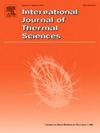Experimental study on dynamics and freezing characteristics of droplet impact on supercooled surfaces
IF 5
2区 工程技术
Q1 ENGINEERING, MECHANICAL
International Journal of Thermal Sciences
Pub Date : 2025-02-22
DOI:10.1016/j.ijthermalsci.2025.109811
引用次数: 0
Abstract
Droplet impact freezing is a natural phenomenon that significantly affects infrastructure and human activities. Despite extensive research on the effects of various parameters on droplet impact and freezing processes, there remains a lack of comparative analysis regarding the degree of influence of these parameters on the impact process, as well as insufficient thermodynamic analyses of the freezing process. This paper experimentally compares the effects of droplet sizes (2.28 mm–3.10 mm), Weber numbers (15–35), and surface temperatures (−30 °C–20 °C) on impact dynamics, including maximum spreading factor and receding ratio, on hydrophilic and superhydrophobic surfaces. The results show that on hydrophilic surfaces, the maximum spreading factor of droplets is significantly influenced by both the Weber number and surface temperature, while on superhydrophobic surfaces, the Weber number plays the primary role. Moreover, the maximum spreading factor and receding ratio of droplets on hydrophilic surfaces are notably higher than those on superhydrophobic surfaces, suggesting a faster heat exchange rate on hydrophilic surfaces. To deepen the understanding of the freezing process and the impact of related parameters on freezing time, particularly the evolution of the freezing front over time, we solved the heat conduction equations for various materials under appropriate boundary conditions. Our analysis determined that the freezing thickness scales with the square root of freezing time. Based on these findings, we propose a model to predict the freezing time of finite-thickness ice sheets. The predictions of our model align well with our experimental data and findings from other researchers, which validates its accuracy.
液滴撞击过冷表面动力学及冻结特性的实验研究
液滴撞击冻结是一种严重影响基础设施和人类活动的自然现象。尽管对各种参数对液滴撞击和冻结过程的影响进行了广泛的研究,但对这些参数对撞击过程的影响程度缺乏对比分析,对冻结过程的热力学分析也不足。本文通过实验比较了液滴尺寸(2.28 mm - 3.10 mm)、韦伯数(15-35)和表面温度(- 30°C - 20°C)对亲水和超疏水表面冲击动力学的影响,包括最大扩散因子和后退比。结果表明:在亲水表面上,液滴的最大扩散因子受韦伯数和表面温度的显著影响,而在超疏水表面上,韦伯数起主要作用;液滴在亲水表面的最大扩散因子和最大退缩比明显高于超疏水表面,表明亲水表面的热交换速率更快。为了加深对冻结过程和相关参数对冻结时间的影响,特别是冻结锋随时间的演变的理解,我们在适当的边界条件下求解了各种材料的热传导方程。我们的分析确定冻结厚度与冻结时间的平方根成正比。在此基础上,提出了一个有限厚度冰盖冻结时间的预测模型。我们模型的预测与我们的实验数据和其他研究人员的发现非常吻合,这证实了它的准确性。
本文章由计算机程序翻译,如有差异,请以英文原文为准。
求助全文
约1分钟内获得全文
求助全文
来源期刊

International Journal of Thermal Sciences
工程技术-工程:机械
CiteScore
8.10
自引率
11.10%
发文量
531
审稿时长
55 days
期刊介绍:
The International Journal of Thermal Sciences is a journal devoted to the publication of fundamental studies on the physics of transfer processes in general, with an emphasis on thermal aspects and also applied research on various processes, energy systems and the environment. Articles are published in English and French, and are subject to peer review.
The fundamental subjects considered within the scope of the journal are:
* Heat and relevant mass transfer at all scales (nano, micro and macro) and in all types of material (heterogeneous, composites, biological,...) and fluid flow
* Forced, natural or mixed convection in reactive or non-reactive media
* Single or multi–phase fluid flow with or without phase change
* Near–and far–field radiative heat transfer
* Combined modes of heat transfer in complex systems (for example, plasmas, biological, geological,...)
* Multiscale modelling
The applied research topics include:
* Heat exchangers, heat pipes, cooling processes
* Transport phenomena taking place in industrial processes (chemical, food and agricultural, metallurgical, space and aeronautical, automobile industries)
* Nano–and micro–technology for energy, space, biosystems and devices
* Heat transport analysis in advanced systems
* Impact of energy–related processes on environment, and emerging energy systems
The study of thermophysical properties of materials and fluids, thermal measurement techniques, inverse methods, and the developments of experimental methods are within the scope of the International Journal of Thermal Sciences which also covers the modelling, and numerical methods applied to thermal transfer.
 求助内容:
求助内容: 应助结果提醒方式:
应助结果提醒方式:


